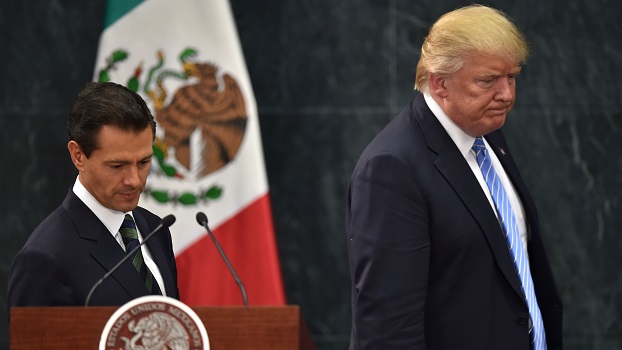
by Stephanie Leutert
At first glance, the U.S.-Mexico security relationship appears to have escaped unscathed from the tensions that have strained the two countries’ economic and diplomatic relations. Overshadowed by the NAFTA renegotiations, U.S. domestic policies, and high-level Twitter spats, discussions on security cooperation have been relegated to bilateral press conferences, where U.S. and Mexican officials promise to strengthen joint security efforts. For a U.S. administration that claims to prioritize law and order and where policy silence is generally preferable to headlines, the bilateral security cooperation seems poised for four years of growth or continuity.
Yet, scratch behind the veneer of boilerplate rhetoric and the reality of bilateral security collaboration is falling short on every mark. The Trump administration’s proposed budget would slash funding for cross-border security programs. There is no articulated strategy for guiding foreign security assistance or security operations. And the U.S. administration’s security policies are often immigration enforcement tactics dressed up with security language. Meanwhile, the Mexican government has appeared publicly unfazed, focused on primarily preserving the bilateral relationship, be it economic, political, or for security issues.
The mutual de-prioritization and lack of ambition with regards to the bilateral security relationship could not come at a more inopportune time. Mexico’s violence hit a gruesome and unprecedented level in 2017, with 25,339 murders (compared to 22,409 in 2011’s previous highpoint), and these murders were no longer concentrated in a handful of cities but spread throughout almost every Mexican state. Meanwhile, the United States’ opioid epidemic shows no signs of slowing down, killing over 40,000 people in 2016 and weighing heavily on U.S. law enforcement and public health services. These challenges—and the policy, guns, money, and corruption that fuel the crises—extend throughout both countries and demand joint responses. However, despite the need to address these cross-border issues together, both the United States and the Mexican administrations have discretely sidelined this part of their relationship.
Drugs and (Foreign Born) Thugs
Contrary to the perception that the security relationship is confined to drugs and thugs, the United States and Mexico’s security collaboration is not limited to any one issue. Over the past two decades, the two countries have embraced a broad definition of security cooperation, encompassing everything from the trafficking of drugs, humans, and weapons to limiting money laundering, locating kingpins, countering cyber threats, and identifying suspicious travelers. While some issues may have stolen the spotlight from time to time, the policy infrastructure and regular funding streams have fostered collaboration on a wide range of challenges.
When candidate Donald Trump was campaigning and later when he took office, his harsh rhetoric on Mexico and Mexicans seemed to jeopardize this cooperation. Yet, contrary to Trump’s portrayal of Mexico as a lawless, violent, and corrupt country, he and his team have toed a different line on security challenges. During his infamous August 2016 campaign trip to Mexico City, Trump stated that “dismantling drug cartels and ending the movement of illegal drugs, weapons, and funds across our border…can only be done with cooperation, intelligence and intelligence sharing and joint operations between our two countries.” Similarly, White House press statements have echoed the virtues of cross-border cooperation and called for the two nations to work together.
Over the past year, high-level officials have repeated this message in international trips and joint press conferences. Secretary of State Rex Tillerson and then Department of Homeland Security Secretary John Kelly symbolically chose Mexico City for their first international trip in February 2017, highlighting the United States’ work with Mexico on a variety of issues including security. While in June 2017, officials from both countries stood side by side in Miami to discuss their joint roles in improving security and economic conditions across Central America.
This language on collaboration may assuage bilateral concerns, but so far it hasn’t materialized into concrete policies. Since Trump assumed office, high-level U.S. officials have failed to articulate a bilateral security strategy. Over the summer of 2017, Trump officials began mentioning that they were shifting tactics to attack organized criminal groups’ business models. Yet, to date there has been no public description of what this narrower approach will entail. In practical terms, the two governments have shrunk their vision, with stepped up collaboration taking place on just two issues: drug trafficking and Central American migration.
The focus on drug trafficking—and more specifically poppy eradication and fentanyl—is in itself nothing new. What is new is that Mexico allowed U.S. and United Nations officials to observe its poppy crop eradication efforts this past summer for the first time in a decade. Around that time, then DHS Secretary John Kelly and head of the CIA Mike Pompeo also allegedly proposed several new poppy eradication initiatives to Trump, none of which have publicly materialized. Also new is the stepped-up joint focus on stopping fentanyl trafficking, with bilateral conferences. However, these efforts are piecemeal policies, with little clarity on how they fit into a broader framework for cooperation or comprehensively address the supply and demand for illicit drugs.
The Trump administration’s other focus has been efforts to slow migration, particularly from Central America. In June 2017, the United States and Mexico co-hosted a two-day conference on Central America’s economic prosperity and security in Miami that was attended by Guatemala, Honduras, and El Salvador’s heads of state. Even within this conference, the final deliverables included few concrete programs or policies, and proposed budget allocations for Central America amount to around $460 million, compared to the Obama administration’s $1 billion FY2016 request. The administration has also highlighted its efforts to help Mexico fortify its southern border, investing in biometrics equipment and training for the country’s migration officials, in an effort to apprehend and deport migrants before they reach the United States.
In general, the U.S. administration’s preference toward diminishing security assistance appears across the entire relationship. In the Trump administration’s proposed FY2018 budget, foreign assistance to Mexico dropped to $87 million (compared to $137 million last year), with reductions across almost every budget line, including international counter-narcotics efforts. While budgetary funding doesn’t necessarily determine the quality of cross-border security cooperation, fewer dollars combined with a murky vision for future cooperation will hinder relationship building and programming.
Not so Bright Future
Yet if the current state of U.S.-Mexico security cooperation appears underwhelming, the future doesn’t look much better. There are at least three issues within both countries that are likely to block any serious attempts at building a better partnership over the coming year.
First, it will be difficult to build any comprehensive strategy for security cooperation as long as the Trump administration continues to address various security challenges with immigration enforcement mechanisms. For example, transnational criminal organizations such as MS13 have headlined the administration’s security talking points and the United States and Mexico could be obvious partners for sharing intelligence on the group and addressing its root causes. Yet the White House’s signature solutions for approaching MS13 and similar groups are to build a border wall, step up deportations, and crack down on sanctuary cities. Beyond not addressing the U.S. citizen members of these groups nor learning from historic deportations trends that spread the gang across Central America, they also ignore the conditions that allow these groups to flourish throughout the region.
This mixing of security issues with immigration enforcement policies has also infused language regarding foreign assistance. The State Department’s FY2018 budget justification explains its security funding for the Western Hemisphere as claiming that it will “shut down transnational criminal organizations and illicit pathways to U.S.
borders, reducing the flow of illegal migration and illicit goods that threaten U.S. safety and security.” U.S. officials have also offered a similar rationale for prioritizing security in Central America, listing “stopping unauthorized immigration” as the factor behind their regional engagement. As long as the Trump administration views security challenges through an immigration lens it will be difficult to increase cross-border security cooperation or design effective policies for a wide range of challenges.
Second, the Trump administration’s empty personnel roster will hinder the ability for the United States to quickly and effectively implement any policy shift. In the State Department, six of the nine top leadership positions are vacant, and it’s a similar story in the Department of Homeland Security, the Department of Justice, and Department of Defense. With so few senior officials, it is difficult to imagine how the administration could logistically launch an ambitious security initiative. For the officials that remain, big-ticket items such as the border wall, domestic migration policy shifts, and NAFTA renegotiations are likely to dominate at least the next year’s agenda.
Finally, Mexican officials are not facing a favorable political timeline for security policy. The upcoming presidential elections in July have effectively sidelined any big policy issues, and political energy will now be channeled into running the presidential campaigns and fending off attacks from opposition parties. The precampaign candidates have also failed to articulate clear platforms and policies on security issues (beyond boilerplate language), making real debate on these issues increasingly doubtful. Regardless of whether the candidates and their teams can come up with a comprehensive approach, any changes to Mexico’s current approach won’t take place until after the new president’s team assumes office in December 2018 at the earliest.
With so many roadblocks in the path toward a stronger security relationship, the future is looking increasingly grim. Both countries may emphasize the importance of the bilateral security relationship, but it’s one thing to state that it is a priority in a speech and another thing to mobilize the resources and political will to make it a reality. Without either attention or dollars, the security relationship is relegated to stagnation at best, with dwindling foreign assistance, fewer personal connections, and lackluster efforts to address security issues. Today’s transnational challenges may be growing in intensity and demanding coordination, but the region’s policymakers don’t seem to be listening.
Stephanie Leutert is the Director of the Mexico Security Initiative at the Robert Strauss Center for International Security and Law at University of Texas at Austin.



